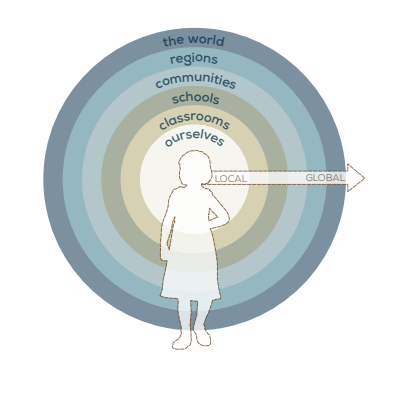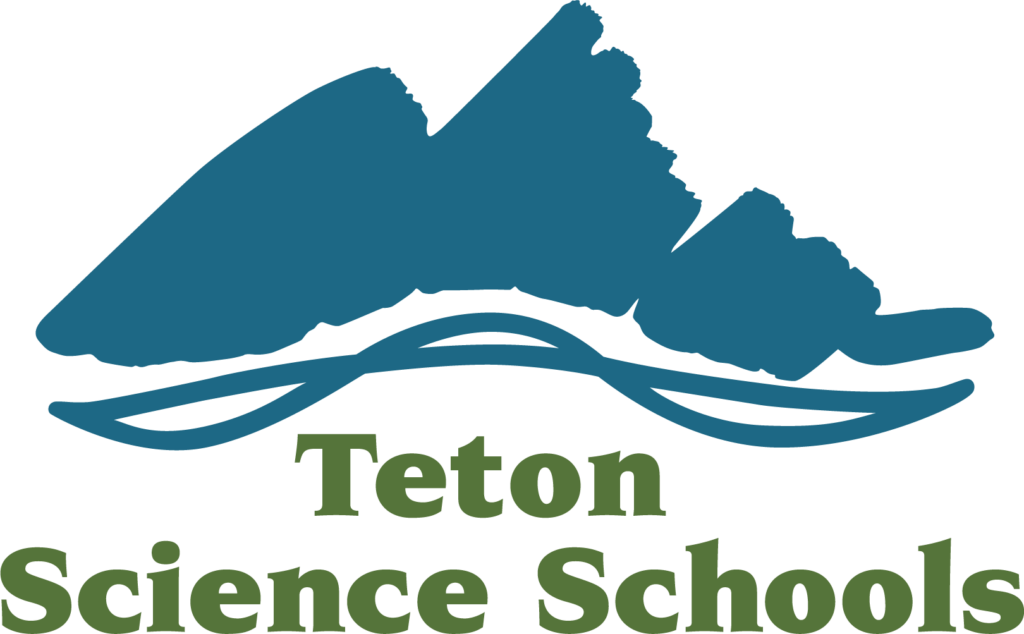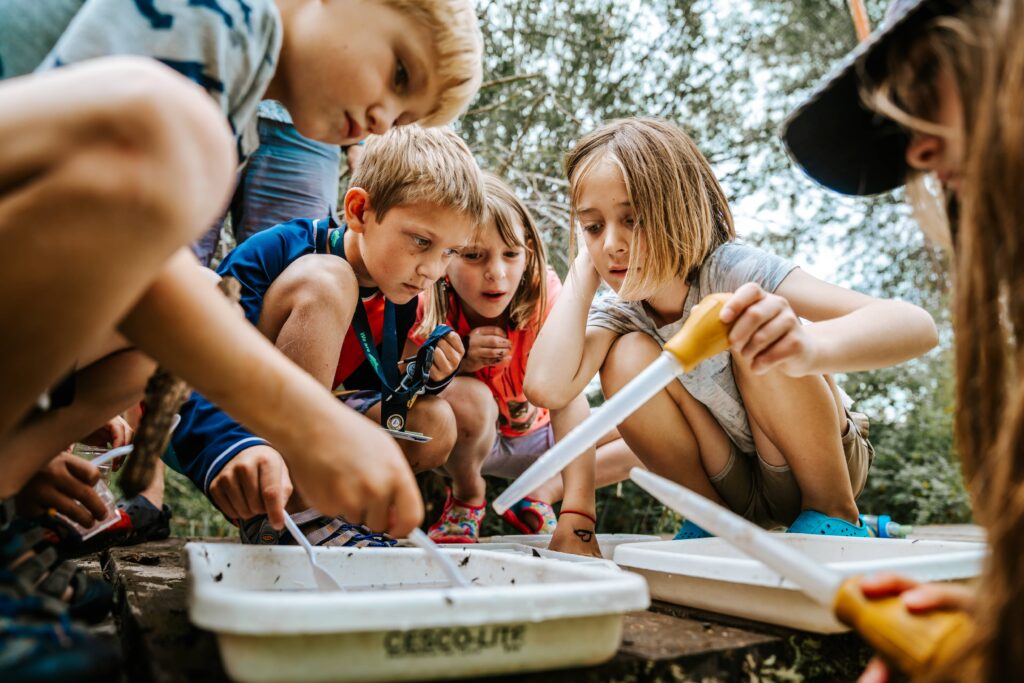An excerpt from What is Place-Based Education and Why Does it Matter by Getting Smart in partnership with eduInnovation and Teton Science Schools
Here at Teton Science Schools, we talk about and experience the power of place on a daily basis. Whether it’s welcoming leaders in our community into our Independent School classrooms, watercoloring aside a glacial lake at the base of the Tetons or venturing outside the classroom walls with teachers in St. Louis, place is at the heart of how we approach every learning experience — it’s why our approach to education is called place-based education.
Over the years, alongside some of our valued partners, we’ve learned a few things about place-based education and how “the approach can serve as a framework to connect learning models, increase the power of our educational system and serve as a foundation for a thriving democracy.” So we’re breaking it down for you, step-by-step.
Let’s get started.
What is Place-Based Education?
If you’re reading this, you’ve likely had a first introduction to place-based education — maybe it was through a program you attended alongside students, maybe it was as part of a continuing education workshop, maybe it was during a breakout session at a national educational conference or maybe your school is just getting started as a place-based school. Whatever the reason, the premise of using the entire world as your classroom can have even the best of us feeling equal parts inspired and intimidated.
No need to worry though — place-based education can look completely different from school to school and place to place. There’s no one right way to do it and that’s the beauty of it.

Here are 3 things to know about place-based education:
- It’s nothing new
In his essay on the history of place-based learning, Gregory Smith writes:
“This approach, with its focus on the incorporation of local knowledge, skills and issues into the curriculum, involves an effort to restore learning experiences that were once the basis of children’s acculturation and socialization prior to the invention of formal schools.”
Before formal education, “the great majority of children learned within the context of their families, neighborhoods and communities as they watched, listened to and imitated adults, explored the natural and human-made world and interacted with one another” (Smith, 2016).
While the approach widely diminished with the rise of industrialization and standardization in the 20th century, it is once again emerging as a promising approach “to help students find purpose and develop the knowledge, skills and dispositions to thrive as adults” (McClennen, 2019).
2. It connects learners to their communities and the world around them
Place-based education is designed to connect what students are taught in school to real-world challenges, opportunities and connections; learning experiences match the complexities of real life and are taught through an integrated, interdisciplinary and frequently project-based approach where all learners are accountable and challenged. Students work towards the production of “high quality products and performances… modeled after real-world formats, guided by professional models and created for an audience beyond the classroom” (source) — celebrations of learning that impact communities for the better.
3. It’s anytime, anywhere learning
It’s never been easier to learn anything — anytime, anywhere. Provided an internet connection, powerful learning experiences are at the fingertips of just about anyone with a device. And it’s not unusual to hear the phrase “anytime, anywhere learning” applied to such “wifi-enabled” scenarios. What’s unfortunate is that in reducing these “anytime, anywhere learning” experiences to those enabled by technology, we fail to fully acknowledge their vast potential beyond the screen.
Place-based learning can truly happen anytime, anywhere — in cities, in rural towns, in parks, virtually, in classrooms, in museums and even, in our own backyards. What matters is that the experience leverages the power of place to personalize learning and “equip students with the tools and skills they need — through authentic experiences — to collaborate, think critically and solve complex challenges” (source).
Place-based education enables personalized learning by:
-
-
- Giving students “voice and choice” in determining what, how, when and where they learn
- Tailoring learning to each student’s strengths, needs and interests
- Ensuring mastery of high academic standards
- Promoting student agency
-

Why is place-based education beneficial?
Under the umbrella of place-based education, learning can take many forms — from informal to formal, from out-of-school individual and family experiences to teacher-led or classroom based activities, and from one lesson experiences to fully-designed place-based education programs — the benefits of which, can impact everyone including students, teachers, families, communities and society as a whole.
Overall, the primary goals of place-based education are to increase student engagement, boost academic outcomes, impact communities and promote an understanding of the world around us. Beyond these goals, other benefits include:
- Learning is grounded in local communities and contexts
- Learning experiences are student-centered and personalized
- Learning is relevant and engaging
- Social-emotional learning can be a priority
- Instruction can be interdisciplinary
- Lessons can be inquiry-based
- Students can be challenged to see the world through ecological, political, economic and social lenses
- Students can have more agency and autonomy — boosting motivation and persistence
- Design-thinking can be encouraged
- Students can meet deeper learning outcomes
- Students gain a better appreciation and understanding of the world around them

Getting Started
Now that you’ve got a firm basis on what place-based education is and why it’s beneficial, it’s time to get practical. Here are three first steps in getting started with place-based education.
- Know where to start
There are just as many ways to implement place-based education as there are places in which to implement it. Rather than being overwhelmed by the possibilities, it can be useful to think about getting started in two ways:

-
-
- Local-to-Global Model: Place begins first with the student’s understanding of themselves and their role in the community and expands, like concentric rings, to classrooms, schools, communities, regions, and the world.
-
Example: Students examine electric bill for the school during different seasons. Through observations of behavior and interviews (inquiry), they determine that electricity use is higher during the winter due to the use of electric heaters. Students design and install door insulators to reduce heat loss after experimenting with various ways to insulate.

-
-
- The Continuum: Entry points to place-based learning evolve along a continuum that moves from primarily teacher-centered to primarily learner-centered.
-
Example: Students notice the frequency in which blackouts are occurring at school and ask the driving question: “Why are blackouts happening at school?” (inquiry). Teacher delivers a lecture on power and work. Students interview a power company employee and take a field trip to tour the local power station. Students design solutions and write to the local power company (interdisciplinary).
2. Get familiar with the place-based education design principles
At the heart of every place-based activity, project or full-blown unit lies six place-based learning design principles. Knowing what they are and how they inform the development of place-based learning is a key first step in designing your first place-based learning experience. We’ve even provided project examples for each principle!

Local to Global Context: Local learning serves as a model for understanding global challenges, opportunities and connections.
-
-
-
- Project Example: The Tiny Home Project
-
-
Learner-Centered: Learning is personally relevant to students and enables student agency.
-
-
-
- Project Example: The Farm Day Projects
-
-
Inquiry-Based: Learning is grounded in observing, asking relevant questions, making predictions, and collecting data to understand the economic, ecological, and socio-political world.
-
-
-
- Project Example: The Empty Bowls Project
-
-
Design Thinking: Design thinking provides a systematic approach for students to make meaningful impact in communities through the curriculum.
-
-
-
- Project Example: The Bee Home Project
-
-
Community as Classroom: Communities serve as learning ecosystems for schools where local and regional experts, experiences and places are part of the expanded definition of a classroom.
-
-
-
- Project Example: The “Oh Deer!” Project
-
-
Interdisciplinary Approach: The curriculum matches the real world where the traditional subject area content, skills and dispositions are taught through an integrated, interdisciplinary and frequently project-based approach where all learners are accountable and challenged.
-
-
-
- Project Example: The Project Checking All the Boxes
-
-
3. Just start
Like with any change we make in our everyday lives, preparing to make the change is often the easier part of starting than the actual starting. But alas, the time always comes to put our fears aside, rip the bandaid off, and just give it a go. Our biggest advice: start small.
Looking for more? Founder and President of CraftED Curriculum, Jennifer Pieratt, offers some great advice in her article, Five Tips for Testing the Place-Based Education Waters.

Check out our Student Project database for more inspiration!
Build your Place-Based Education Community
Community is what place-based education is all about. Not only can it become the basis for student inquiry and real-world problem solving, but it can also become the backbone that keeps you motivated, pushes you in taking the next step and celebrates all of the hard work you’re putting in for your students, your school and, of course, your community itself.

Here are three ways to start building your place-based education community:
- Create Local Partnerships
One of the biggest questions you’ll likely find yourself asking as you and your students design your place-based projects is: “Where or who in the community could help bring this unit/project to life?” While the initial process of reaching out those organizations or individuals can be quite time consuming, the end product — your community partner database — will be extremely valuable to your place-based endeavors in the future. Seek out parent volunteers, create an email templates and get your students involved in the process!
2. Participate in Place-Based Professional Development
Connecting with members of your own community is one thing, but what about connecting with those that are working through their own versions of place-based education implementation? Chances are the questions, fears or yearnings for something more you’re experiencing as you work to incorporate place-based principles into your curriculum are being had by someone else. Registering for a workshop or course is a great way to connect with other place-based education professionals. Better yet, find one that is taught using place-based practices!
Check out professional development opportunities through our Teacher Learning Center
3. Join a Place-Base School Network
What’s better than having a go-to group of educators to turn to in your place-based education endeavors? For us, it’s having a network of place-based focused schools all across the country. Networks like Place Network are working with administrators, teachers and students in rural communities all over the country to not only implement place-based education in their schools, but form connections between the schools to share best practices, learnings, challenges and wins along each school’s journey.
Learn more about the Place Network
Resources for Place-Based Education
Looking for more? We’ve put together a list of great resources to take your place-based education knowledge even further.
Articles
-
-
- The Best of Both Worlds: A Critical Pedagogy of Place by David A. Gruenewald
- The Community as a Learning Laboratory: Using Place-Based Education to Foster a Global Perspective in the Social Studies by Brad M. Maguth and Jeremy Hilburn
- Place-Based Education: What is Its Place in the Social Studies Classroom? by Cynthia Williams Resor
- Place-Based Education by Gregory A. Smith
- Science Education in a Classroom Without Walls: Connecting Young People Via Place by Kimberly Wilson and Kellie Stemp
-
Books
-
-
- Place-Based Education by David Sobel
- Seedfolks by Paul Fleishman | YA book | 13 diverse narrators, living in the same neighborhood in Cleveland, who are brought together when a young Korean American girl plants a few seeds in a vacant lot.
-
Talks
Whitepapers by Getting Smart in partnership with eduInnovation and Teton Science Schools
Websites
-
-
- Getting Smart | Check out their Place-Based Education Series
- Rural Schools Collaborative
-
Centers & Institutes


